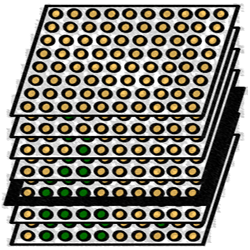
Scanning Order Strategies for Bitplane Image Coding


|
Scanning Order Strategies for Bitplane Image Coding |

|
|
An important aspect of image and video codecs is the scanning order employed to code the (transformed) coefficients of an image. Adequate scanning orders may help to reduce the computational costs of the codec and to improve the coding performance. This line of research explores scanning order strategies for the coding of wavelet-transformed images utilizing a rate-distortion perspective. This webpage provides an example on how different scanning orders code wavelet data to illustrate the differences among them. This work has been awarded with a distinguished R-Letter by the IEEE Communications Society issued in the MMTC R-letter of June 2013. |
|
ABSTRACT: Scanning orders of bitplane image coding engines are commonly envisaged from theoretical or experimental insights, and assessed in practice in terms of coding performance. This work evaluates classic scanning strategies of modern bitplane image codecs using several theoretical-practical mechanisms conceived from rate-distortion theory. The use of these mechanisms allows distinguishing those features of the bitplane coder that are essential from those that are not. This discernment can aid the design of new bitplane coding engines with some special purposes and/or requirements. To emphasize this point, a low-complexity scanning strategy named hybrid is proposed. Experimental evidence illustrates, assesses, and validates the proposed mechanisms and scanning orders. The HYBRID algorithm introduced in this work uses optimization procedures that have to be carefully implemented (see the manuscript for a detailed explanation). The Java implementation of the HYBRID codec is based on our JPEG2000 implementation BOI (version 1.6). Below, the JPEG2000 and the HYBRID codecs (both using the CAD probability model) are provided: |
|
JPEG2000 BOI2-1_6.tar.gz 485K |
HYBRID HYBRID.tar.gz 481K |
|
|
Another contribution of this work is the evaluation of several scanning orders. The coding of this codeblock of 32x32 using different scanning orders is illustrated below (see the manuscript for more details). Each point depicted in the video sequences represents one coefficient of the codeblock. Coefficients that were, and were not, significant in previous bitplanes are depicted in green and yellow, respectively, whereas coefficients that become significant in the current bitplane are depicted in red. The coefficient currently coded is depicted with a black circle. |
| SCANNING ORDER STRATEGY | |||||
| BP | SINGLE PASS | TWO PASSES | JPEG2000 | ADAPTIVE |
ADAPTIVE (OPTIMAL) |
| 6 | onePass-BP6 | twoPass-BP6-SIG | JPEG2000-BP6-CP | ASO-BP6 | ASO_OPT-BP6 |
| 5 | onePass-BP5 |
twoPass-BP5-SIG twoPass-BP5-REF |
JPEG2000-BP5-SPP JPEG2000-BP5-MRP JPEG2000-BP5-CP |
ASO-BP5 | ASO_OPT-BP5 |
| 4 | onePass-BP4 |
twoPass-BP4-SIG twoPass-BP4-REF |
JPEG2000-BP4-SPP JPEG2000-BP4-MRP JPEG2000-BP4-CP |
ASO-BP4 | ASO_OPT-BP4 |
| 3 | onePass-BP3 |
twoPass-BP3-SIG twoPass-BP3-REF |
JPEG2000-BP3-SPP JPEG2000-BP3-MRP JPEG2000-BP3-CP |
ASO-BP3 | ASO_OPT-BP3 |
| 2 | onePass-BP2 |
twoPass-BP2-SIG twoPass-BP2-REF |
JPEG2000-BP2-SPP JPEG2000-BP2-MRP JPEG2000-BP2-CP |
ASO-BP2 | ASO_OPT-BP2 |
| 1 | onePass-BP1 |
twoPass-BP1-SIG twoPass-BP1-REF |
JPEG2000-BP1-SPP JPEG2000-BP1-MRP JPEG2000-BP1-CP |
ASO-BP1 | ASO_OPT-BP1 |
| 0 | onePass-BP0 |
twoPass-BP0-SIG twoPass-BP0-REF |
JPEG2000-BP0-SPP JPEG2000-BP0-MRP JPEG2000-BP0-CP |
ASO-BP0 | ASO_OPT-BP0 |
| CODEBLOCK DATA | |||||
| Do you have a big screen and your browser supports HTML5? TRY THIS | |||||
| PAPER: F. Auli-Llinas and M.W. Marcellin, Scanning order strategies for bitplane image coding, IEEE Trans. Image Process., vol. 21, no. 4, pp. 1920-1933, Apr. 2012. (DOI:10.1109/TIP.2011.2176953, doc.pdf5.8M) |
| PRESENTATION: slides.pptx24M |